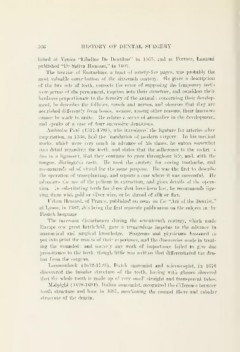Page 406 - My FlipBook
P. 406
366 HISTORY OF DENTAL SUEGERY
lished at Venice "Libellus De Dentibns" in 1563, and at Ferrara, Lanzoni
]iublishetl "De Saliva Humani," in 160-^.
The treatise of Eustachius, a tract of ninety-five pages, was probably the
most valuable contribntion of the sixteenth century. He gives a description
of the two sets of teeth, corrects the error of supposing the temporary teeth
were germs of the permanent, inquires into their structure, and considers their
hardness proportionate to the ferocity of the animal ; concerning their develop-
ment, he describes the follicles, vessels and nerves, and observes that they are
nourished differently from bones, because, among other reasons, their fractures
cannot be made to unite. He relates a series of anomalies in the development,
and speaks of a case of four successive dentitions.
Aniljroise Pare (1517-1590), who introduced the ligature for arteries after
amputation, in 1536, laid the foundation of modern surgery. In his medical
works, which were very much in advance of his times, he enters somewhat
into detail regarding the teeth, and states that the adherence to the socket is
due to a ligament, that they continue to grow throughout life, and, with the
tongue, distinguish taste. He used the cautery for curing toothache, and
recommends oil of vitriol for the same purpose. He was the first to describe
the operation of transplanting, and reports a case where it was successful. Ho
advocates the use of the pelican in extraction, and gives details of the opera-
tion. In substituting teeth for those that have been lost, he recommends liga-
ting them with gold or silver wire, or by thread of silk or flax.
Urban Hemard, of France, published an essay on the "Art of the Dentist,"
at Lyons, in 1582, this being the first separate publication on the subject in tlie
French language.
The incessant disturbances during the seventeenth century, which made
Europe one great battlefield, gave a tremendous impetus to the advance in
anatomical and surgical knowledge. Surgeons and physicians hastened to
put into print the results of their experience, and the discoveries made in treat-
ing the wounded; and scarcely any work of importance failed to give due
prominence to the teeth, though little was written that differentiated the den-
tist from the surgeon.
Leeuwenhoek (1632-1723), Dutch anatomist and microscopist, in 1678
discovered the tubular structure of the teeth, having with glasses observed
that the whole tooth is made up of very small straight and transparent tubes.
Malpighi (1628-1694), Italian anatomist, recognized the difference between
tooth structure and bone in 1687, mentioning the enamel fibers and tubular
structure of the dentin.


